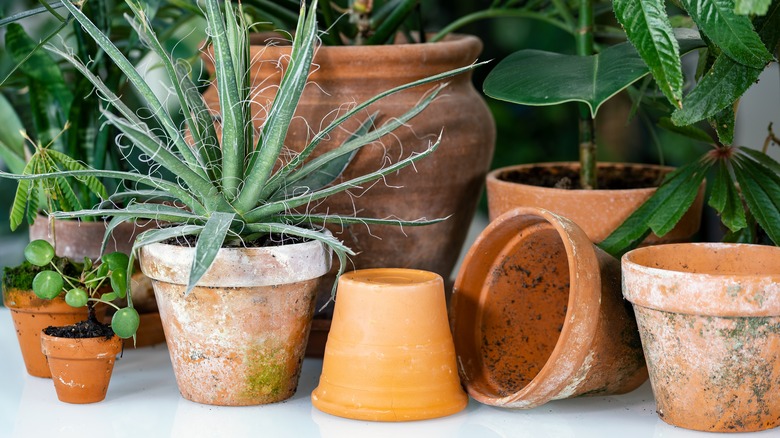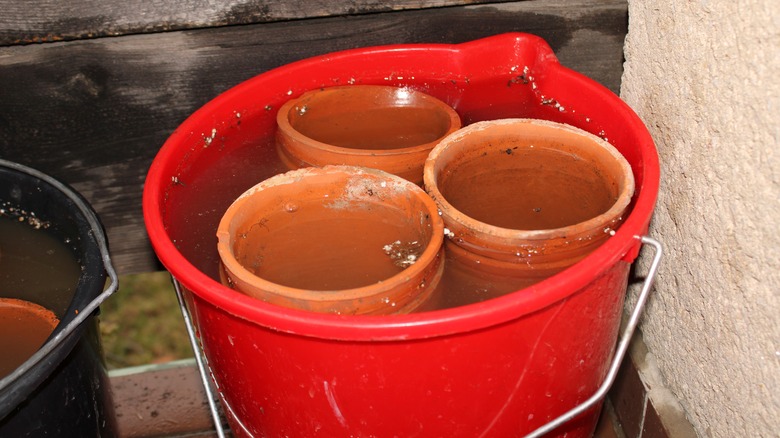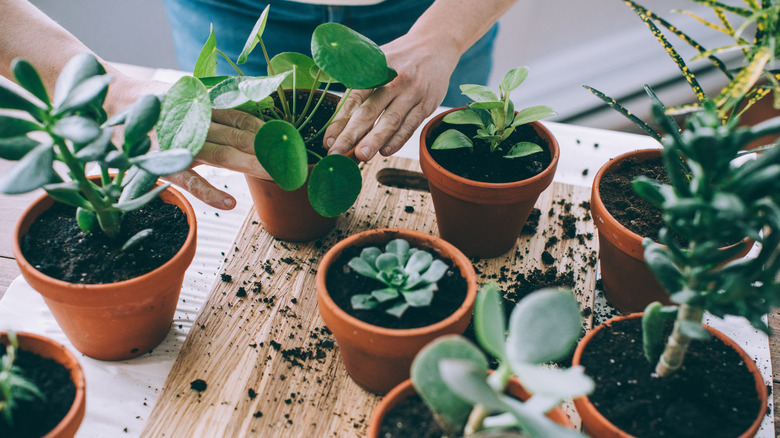The Ingredient That'll Make Your Clay Pots Look Good As New
We've all fallen victim to having a plant move to the great beyond, leaving behind a crusted clay pot with shriveled plant debris and dry soil. While your first response might be to toss the pot in the trash and start over, there is a super simple solution lurking in your kitchen pantry that will restore your terracotta pot to its former glory. Look no further than a bottle of white vinegar, a scrub brush, and a large basin. These three tools are a great DIY solution to removing unsightly stains and stubborn debris.
Sanitizing and cleaning with vinegar before potting a new plant is important for several reasons. First, it helps to remove any potential pathogens that may be present on the pot's surface, reducing the risk of disease transmission to the new plant. Secondly, sanitizing removes any mineral deposits, hard water stains, or dried-out soil that may hinder the plant's growth or affect its overall health. And, lastly, cleaning the pot ensures an ideal environment for the new plant, promoting optimal growth and preventing any potential issues that may arise from using a dirty or contaminated pot.
How to clean pots with a vinegar solution
Cleaning clay pots with a vinegar solution is a simple and effective method. First, gather the necessary materials: You will need white vinegar, water, a bucket or basin, and a scrub brush or sponge. Next you'll need to dilute the vinegar by adding one-part of white vinegar to three or four-parts water into the vessel. This dilution will ensure that the vinegar is not too strong and will not damage the clay pots. For tougher stains, try a stronger solution with a one-to-one ratio of vinegar and water. With this method, it's important to test the solution out on an inconspicuous part of the pot first to be sure it doesn't stain the exterior.
To apply the vinegar solution to the clay pots, place them in the mixture, ensuring that they are fully submerged. Let them soak for at least 30 minutes to allow the vinegar to penetrate and break down any debris. After soaking, gently scrub the pots while focusing on areas with mineral deposits, hard water stains, or dried-out soil. Then, rinse them thoroughly with clean water to remove any remaining vinegar solution and loosened residue. You can use a hose or a sink with running water for this. After rinsing, allow the pots to air dry completely before using them again.
Why the vinegar bath works
Using a vinegar solution is an effective and natural way to clean clay pots due to its acidic properties. Acetic acid acts as a mild solvent to help break down and dissolve various types of debris. The acidity of vinegar also helps to kill bacteria, fungi, and other microorganisms that may be present on the surface of the pot. These life-forms can thrive in the moist environment, especially if it has been used for planting. The acetic acid in vinegar helps to remove these microorganisms, reducing the risk of contamination and ensuring a clean and healthy environment for future plants.
When clay pots are exposed to the elements and used for planting, they can accumulate mineral deposits and hard water stains over time. These deposits can make the pots look dull and dirty. The acetic acid in vinegar helps to dissolve these mineral deposits, making it easier to remove them from the surface of the pot. Additionally, the acidic nature of vinegar helps to break down dried-out soil, making it easier to clean and prepare the pot for reuse.


